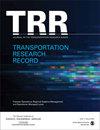Hierarchical Automated Machine Learning Approach for Self-Optimizable Driving Distraction Recognition Based on Driver’s Lane-Keeping Performance
IF 1.8
4区 工程技术
Q3 ENGINEERING, CIVIL
引用次数: 0
Abstract
With the enrichment of smartphone uses, phone-related driving distractions have become a threat to driving safety. One way to mitigate driving distractions is to detect them and provide real-time warnings. However, most existing driving distraction recognition algorithms are pretrained models composed of structures, hyperparameters, and parameters that may not be able to account for drivers’ individual differences and, thus, might result in low model accuracy. This study proposes a domain-specific hierarchical automated machine learning (HAT-ML) model that self-learns personalized optimal models to detect driving distractions from vehicle movement data. The HAT-ML model integrates key modeling steps into auto-optimizable layers, including knowledge-based feature extraction, feature selection by recursive feature elimination, automated algorithm selection, and hyperparameter autotuning by Bayesian optimization. In our eight-degrees-of-freedom driving simulator experiment, we demonstrated the effectiveness of the proposed model using three driving distraction tasks: browsing a short message, browsing a long message, and answering a phone call. The HAT-ML model was found to be reliable and robust for predicting phone-related driving distraction, achieving satisfactory results with a predictive accuracy of 80% at the group level and 90% at the individual level. Moreover, the results revealed that each distraction and driver type required different optimized hyperparameter values, which demonstrated the value of utilizing HAT-ML to detect driving distractions. The key elements that dominated the performance of the model have several theoretical and practical implications. The proposed method not only enhanced performance, but also provided data-driven insights about model development.基于车道保持性能的自优化驾驶分心识别的分层自动机器学习方法
随着智能手机使用的增加,与手机相关的驾驶分心已经成为驾驶安全的威胁。减轻驾驶分心的一种方法是检测它们并提供实时警告。然而,大多数现有的驾驶分心识别算法都是由结构、超参数和参数组成的预训练模型,这些模型可能无法解释驾驶员的个体差异,因此可能导致模型精度较低。本研究提出了一种特定领域的分层自动机器学习(HAT-ML)模型,该模型可以自我学习个性化的最佳模型,以从车辆运动数据中检测驾驶干扰。HAT-ML模型将关键建模步骤集成到可自动优化的层中,包括基于知识的特征提取、递归特征消除的特征选择、自动算法选择和贝叶斯优化的超参数自动调谐。在我们的八自由度驾驶模拟器实验中,我们通过三个驾驶分心任务:浏览短消息,浏览长消息和接电话来证明所提出模型的有效性。HAT-ML模型在预测与手机相关的驾驶分心方面是可靠和稳健的,在群体水平和个人水平上的预测准确率分别为80%和90%,取得了令人满意的结果。此外,结果显示,每种分心和驾驶员类型需要不同的优化超参数值,这证明了利用HAT-ML检测驾驶分心的价值。决定模型性能的关键因素有几个理论和实践意义。所提出的方法不仅提高了性能,而且提供了关于模型开发的数据驱动的见解。
本文章由计算机程序翻译,如有差异,请以英文原文为准。
求助全文
约1分钟内获得全文
求助全文
来源期刊

Transportation Research Record
工程技术-工程:土木
CiteScore
3.20
自引率
11.80%
发文量
918
审稿时长
4.2 months
期刊介绍:
Transportation Research Record: Journal of the Transportation Research Board is one of the most cited and prolific transportation journals in the world, offering unparalleled depth and breadth in the coverage of transportation-related topics. The TRR publishes approximately 70 issues annually of outstanding, peer-reviewed papers presenting research findings in policy, planning, administration, economics and financing, operations, construction, design, maintenance, safety, and more, for all modes of transportation. This site provides electronic access to a full compilation of papers since the 1996 series.
 求助内容:
求助内容: 应助结果提醒方式:
应助结果提醒方式:


